|

|
Number of versions:
1
Edition: April 17, 2010
|

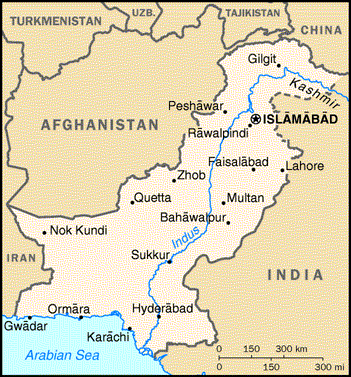
In 1940 was a demand for the formation of independent states for Muslims in
the East and the West of  British
India, a mainly Hindoe state. This resulted in a united Pakistan with two
wings - West Pakistan and East Pakistan - that gained independence
from the British on August 14, 1947, so shortly after WW II. Both parts of the
country lie 1600 km from each other. Three wars and a secession at last ended in
the birth of Bangladesh (till than East Pakistan) in December 1971.
British
India, a mainly Hindoe state. This resulted in a united Pakistan with two
wings - West Pakistan and East Pakistan - that gained independence
from the British on August 14, 1947, so shortly after WW II. Both parts of the
country lie 1600 km from each other. Three wars and a secession at last ended in
the birth of Bangladesh (till than East Pakistan) in December 1971.
Because India, and so Pakistan, was part of the British Empire the Waddington
version of Monopoly, i.a. with the London game board, will have been
distributed in this country.
However, Steve Amato found the first inland made Monopoly-like edition early
2010, see under.
Edition: The Bank Game of "New Paktrade"
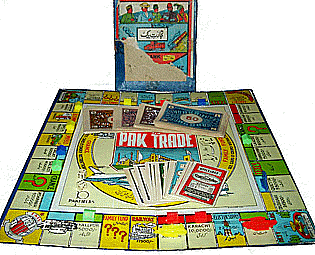 Publisher: Pakfields - Sialkot 1 - W.Pakistan - ±1957.
Publisher: Pakfields - Sialkot 1 - W.Pakistan - ±1957.
Sole distributors: Amiensons Old Post Officie Road, Sialkot 1 (unfortunately not
to be found on the map)
Rules made by: S.M.Hussain - Pakfields Sports
Dimensions of the little box: 17 x 14.5 cm
of the game board: 36 x 36 cm
The game:
This interesting game is owned by Steve Amato - N.Y.
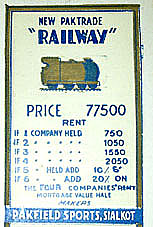 This
is a bilingual game: English and Urdu. All cards are printed one
side in English and in Urdu on the back.
This
is a bilingual game: English and Urdu. All cards are printed one
side in English and in Urdu on the back.
The
name Pak Trade of course indicates Pakistani Trade, but the question is
why a game gets such a name. Besides, at the foot of the Railway card is
the mention "Pakfield Sports, Sialkot" that appears to be one of the
many companies in the industrial town Sialkot mainly specified on export.
However, now it is not clear what the connection can be with a sports articles
manufacturer.
Like the British Waddington editions of that era this game exsist of a small box
for all its accessories and a rather small separate, folded game board of hard
cardboard.
There are 4 color groups of 5
properties each, being scattered over all 4 sides
of the board. And there are 6 Companies, among which an Electric- and Oil
company and 4 transport companies.
We learn from the Rules:
The "New Pak Trade" offers an amusement of the highest order
coupled with decent sport and play. It imports education to enable the players
to become 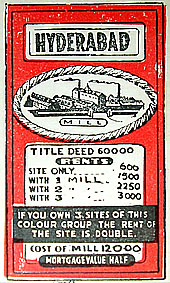 commercial
minded.
commercial
minded.
The idea of the game is to buy and sell properties and build Houses, Hotels,
Theatres, Mills and Markets for the purpose of giving them away on rent and to
derive profit so that one may become the wealthiest player and in the end a
"Trade King".
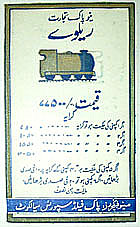
The handling of buying and mortgaging of properties and buildings is the same as
we know from the Waddingtons editions, except for the fact that each color
group has buildings belonging to that group. On the property deed is said what
the building means for the propertiy, i.a. either a house, hotel, theatre,
market or mill. The Rules however, make things a bit confusing.
They are interpreted as thus: In the red
group for example, you must build 3 houses on Gwadar
before you can build 3 hotels on Shikarpur.
And you must have 3 hotels on Shikarpur before you can build 3 theatres
on Karachi. You must have 3 theatres on
Karachi before you can build 3 markets on Sukkar.
You must have 3 Markets on Sukkar before you can build 3 mills on Hyderabad.
This in very strange, since there are not enough building in this game to do so.
It is indeed very confusing.
When the
owner is in Jail the rent is half and when the property is mortgaged the rent
goes to the bank.
The companies are properties to be dealt with by the players mutually,
without reference to the bank, at any agreed price. They can even be owned by
any number of players together. They may share the costs and rents.
There are no Chance nor
Family Fund cards. The action to be taken has to be read from an
instruction card provided and depends on your throw of the dice. At
an odd throw you have to pay the bank otherwise you receive, f.e.:
|
Chance |
Family Fund |
|
|
| 3 thrown: Property repair due to fire, pay 2000. |
7 thrown: Marriage Expenses, pay 3000 |
| 5 thrown: Burglary, pay 10000 |
11 thrown: Food and other House Hold expenses, pay 2500 |
| 6 thrown: Reward for good services, receive from bank 4000. |
6 thrown: Marriage Gifts from each player,
receive 300 |
| 8 thrown: A share in the will of deceased friend,
receive 2000 |
8 thrown: Birthday present from each player, receive
100 |
Jail (Rule No.11) :
If you go in by routine play by an even throw, pay 500
If you go in by routine play by an odd throw, pay 600
If you go in by double throw thrice, pay 700
If you go in by Chance (Rule 9), pay 1000
Pilgrimage or visite to Holy Place (= Rest Park) (Rule
No.13):
2, 4 & 6 thrown: By air route, pay to bank 1000
8, 10 & 12 thrown: By sea route, pay to bank 5000
3, 5 & 7 thrown: By land route, pay to bank 2500
9 or 11 thrown: By land route, as above plus for charity 500
Rest Park (Rule No.14):
Arriving for the first time is free.
Arriving for the 2nd time: pay the bank Rs.50 and for subsequent time pay Rs.100
for each time. (How to keep this under control?)
The spaces are from Start onwards:
Shikarpur - Gwadar
- Chance - Lahore - Rawalpindi
- Texes (read: Taxes!), Quetta
-
Rajshahi
- Rest Park/Comply instructions - Multan - Electric Supply - Karachi
- Hyderabad - Railway - Family Fund, Lyallpur
- Abbottabad - Jail - Peshawar
- Chance - Sialkot - Kalat
- Omnibus - Dacca
(East Pakistan) - Oil Company - Chandpur
(East Pakistan) - Go To Holy/Comply
Instructions - Chitagong -
Family Fund, Sylhet
- Shipline - Sukkar - Airline
- Swat and Texes.
The underlined cities are from East Pakistan, all 5 yellow
properties, but only 2 of them have it mentioned on the board. Lyallpur = today Faisalabad.
Because of the fact the cities and villages used on the board come from both
parts of united Pakistan the game must have been made between 1947 and 1971, so
let us say in ±1957.
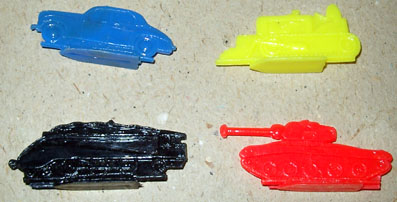 The property
deeds
are printed in black with 1 support color on white paper.
The property
deeds
are printed in black with 1 support color on white paper.
The banknotes (11x7.5 cm) are printed
in color on white paper with their denominations in red
in the center. The denominations are: 50
- 100 - 500
- 1000 - 5000
- 10000 - 50000
and 100000. The
banknotes show 4 currencies, viz. Rs. (rupee)
- $ (dollar) - Frcs (francs)
and £ (pound) and players may use the values of
their own countries currency.
There are only 4 tokens: a tank - train
- car and a tractor.
Interesting! These tokens were also used in Britain in the fifeties! See the "White
long box of 1957". These light metal tokens may well be a Pakistani
product.
There are only 16 plastic buildings 4 of each colr: red
-
green - blue and
yellow.
The white dice are small with black pips.
The Rules are in a small booklet of 11x13 cm, containing15 pages.